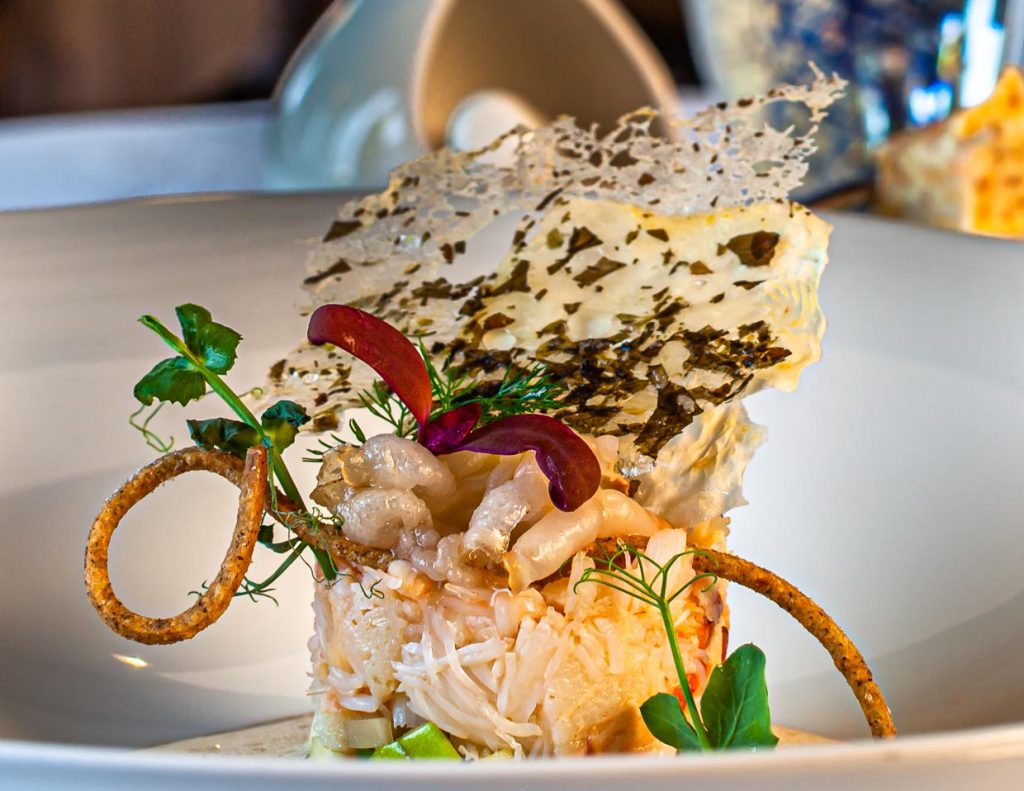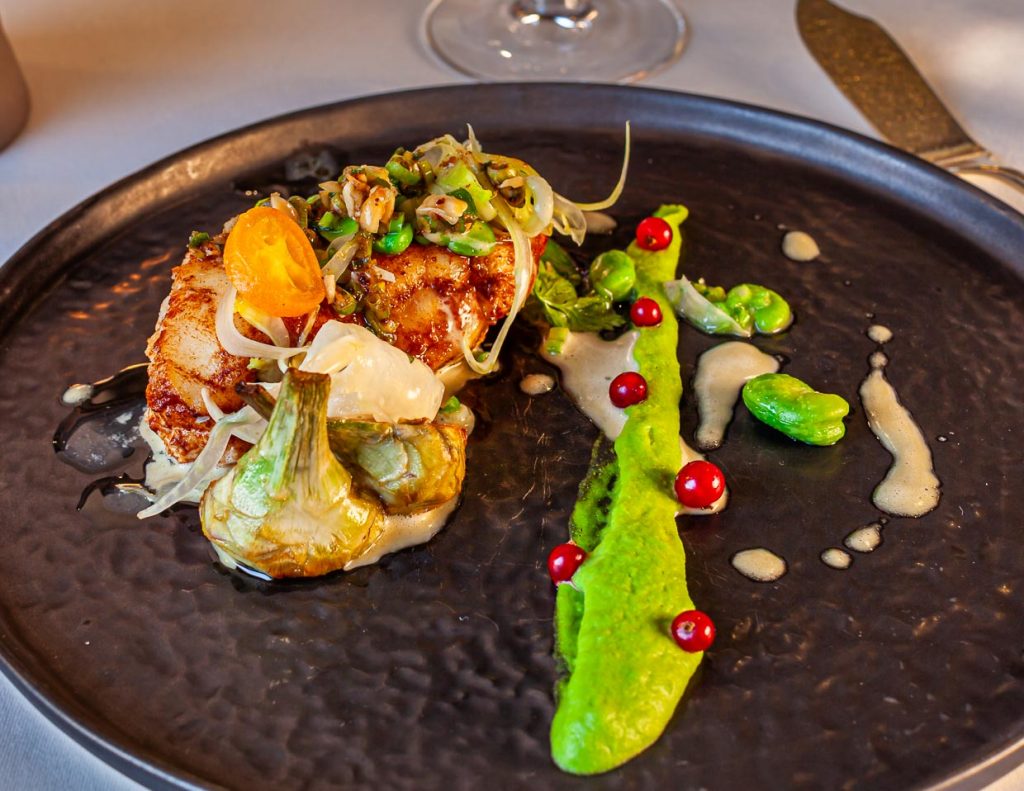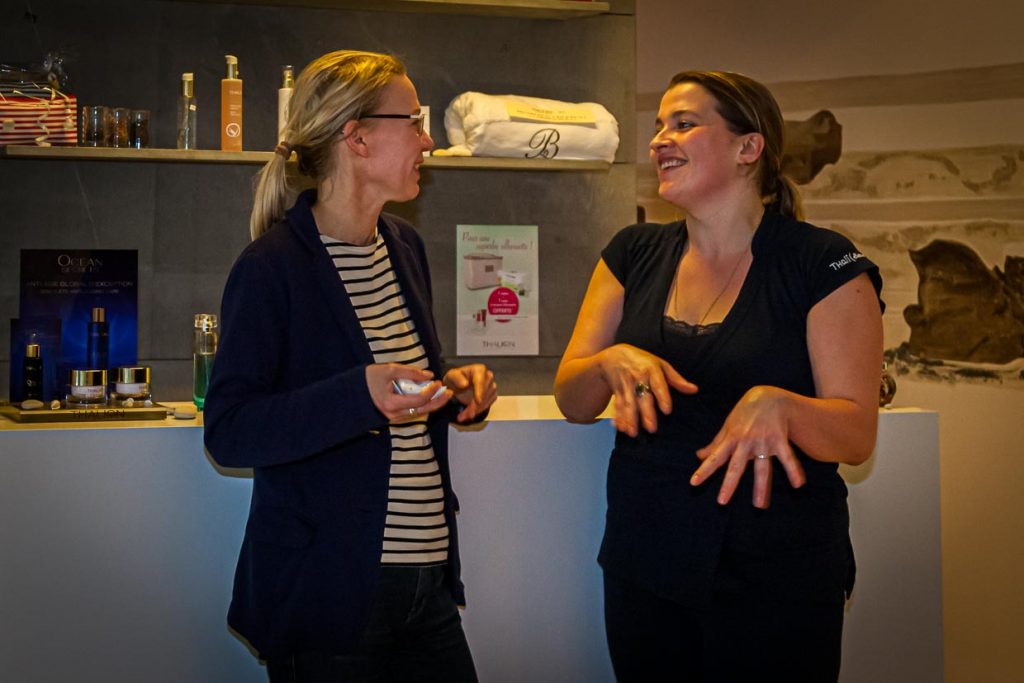That was new. For the first time we approach Brittany by sea. The night crossing with Brittany Ferries, which connects Cornwall with Brittany, was quiet. Already on board one is tuned in to the country and its people with gentle Brittany sounds. Just as soft as the wake-up call on board, however, the rain falls, enveloping the port of Roscoff in a murky gray.
Click here for a detailed report on the passage with Brittany Ferries

Good that the first destination to study Breton cuisine is not far. The 4-star Hotel Brittany & Spa, a Relais & Châteaux establishment, is located right next to the old Sainte-Barbe chapel. From the hill of the chapel and also from many of the rooms in the Brittany & Spa, you have a magnificent view of the old harbor and the old town of Roscoff.

Loïc Le Bail is a true Breton. He actually wanted to become a carpenter, absolutely wanted to do something with his hands and design. It was not easy to find a suitable apprenticeship. That’s when he was advised to learn how to be a chef. After all, that would be similar and definitely creative, using his hands. With Loïc, you quickly notice when you watch him in his kitchen, there is also a lot of intuition and passion. He can be just as enthusiastic about the smallest herb as he is about thick, blue-spotted lobsters from local waters.

Fresh food paradise Roscoff
Loïc Le Bail has held a Michelin star at the Brittany & Spa hotel’s restaurant since 2009, and he’s been a chef in that kitchen for an incredible 27 years. So not only does he walk through his kitchen realm with somnambulistic confidence, but he also knows his producers inside out. We notice this when he packs us into his van and takes us off to the fresh produce paradise of Roscoff.
Barely a kilometer into the journey, we are already at the fish wholesaler Gaby Béganton. This is where Loïc Le Bail gets his fish and seafood. It’s Saturday and the fish department is closed, but they still let us into the hall for crustaceans and other sea creatures.

Loïc walks between the basins, rolls up the sleeve of his jacket, fearlessly reaches into the water and shows us the specialties: including huge lobsters from the cold waters of the Atlantic, but also exotic fellows, such as a small African lobster, of which Loïc does not think so much in terms of taste. His attention is focused on the local varieties. Roscoff is a crab and lobster area. Much of the tank is filled with crabs. As we enter the hall, a truck filled with crabs, lobsters and langoustines is just leaving the loading dock. It still has to reach the Armorique of the Brittany Ferries for its destination England, with which we came today.

Loïc draws our attention to another specialty, Ormeau, the abalone, a type of snail often mistaken for a clam because of its pearly shell. The muscle meat of the abalone is considered a delicacy. The price per kilo is 30 euros. They are served deep-fried. However, Loïc limits, they are excellent in taste only from November to March.

And so the marine expertise continues with star chef Le Bail. Animal after animal he pulls out of the water and explains the special features. He strolls through this paradise of freshness, enjoying the privilege that his region offers him such a wide variety of the best products free of charge.

Allow me: Camus from the thistle family
After the sea, it’s off to the countryside. We continue to a farmer who also has his farm not far from the restaurant. There are artichokes in the fields all around. Their harvest season has just begun and goes from May to November.

Artichokes thrive very well in Brittany’s comparatively mild climate due to the warm Gulf Stream. Around 5,000 family farms have joined together to form a cooperative in the Finistère region. They call their vegetable thistle Camus, which means snub nose, because of its large, ball-like shape.

We trudge across the muddy field. Loïc knows where the strawberries are, in which greenhouse the zucchinis are just blooming and that the season for cauliflower is coming to an end. A chef completely in tune with the treasures of his region.

Small leaf – big taste
Our third supplier stop is Loïc’s friend Patrice Mallegol. Mallegol’s greenhouses are home to tomatoes, potatoes, zucchini, green beans and the pink onion, another Roscoff botanical celebrity.

But Loïc’s soft spot is the herbs. He leads us through the rows of tables in the greenhouse, incessantly plucking little leaves for us to taste. Or he calls out to his friend Patrice to go get the red shiso and the green mustard.

The tiny leaves contain concentrated aroma. Loïc Le Bail uses the aromatic spectrum of the herbs, which sometimes taste like radish, green mustard, kohlrabi, beet or cress. Later, we will see that the herbs, like a painter’s palette of colors, are at the ready in his kitchen to give the dishes a more than decorative finish.

Algae – vegetables from the sea
This morning excursion to the surrounding suppliers of the Brittany & Spa was a very convincing demonstration of the kitchen philosophy of the house. Back in the kitchen, Loïc introduces us to yet another typically Breton ingredient that is in season in the spring: Nori, dulse, kombu or sea lettuce, seaweed is the vegetable from the sea and is used as an accent in Breton cuisine.

Many seaweeds are harvested directly from the sea in Roscoff. Several local companies specialize in seaweed: from thalassotherapy, the external application of seaweed, to the production of delicacies such as seaweed tartar, chutneys or dried seaweed for use in the kitchen.

We will always encounter seaweed in Loïc Le Bail’s dishes. What’s more, his Japanese sous chef Kazunori Tanigawa has considerable expertise in sea vegetables, and the Breton and the Japanese exchange ideas on the preparation techniques and processing of seaweed.
“Le coup de feu – Hot phase in the kitchen”.

The restaurant is full and orders are called every minute. No wonder, because Loïc Le Bail’s star cuisine has spread as far as Paris. And if, like us, you’ve had the chance to take a look behind the scenes and observe Loïc Le Bail in his kitchen – which, by the way, he completely redesigned years ago according to his own ideas – then it’s no wonder that he has a loyal regular clientele. There is no sign of the tension in the kitchen in the restaurant. All six cooks are highly concentrated and well attuned to each other. The handovers to service go hand in hand.

The restaurant is only open in the evening. You can order á la carte or choose between the Plaisir menu for 58 euros, the Tentation menu for 72 euros or the Saveur menu for 92 euros. All menus are currently under the heading “The spring cuisine of Loïc Le Bail”. The implementation of regional and seasonal ingredients, which we had the opportunity to visit in the morning, is brilliant in every respect. The restaurant offers a beautiful view of the old port of Roscoff as well as the offshore Ile de Batz through the many window arches of the salon from each of the 20 or so tables. Tables are spaced generously, and service is attentive and friendly. The restaurant is always fully booked on weekends during the season. In addition to hotel guests, there are many regular customers.
All good things come in threes

After five kinds of bread have already been served with the onion butter with the famous pink onions from Roscoff, a salvo of three greetings comes from the kitchen. Especially exciting, the asparagus ice cream with olive oil. For us, who grew up with steaming asparagus spears served with hollandaise sauce, this cold version is a real revelation. The creamy and intense asparagus ice cream sits in a rhubarb cream and is studded with an octopus chip. Next to it is a crab soup with fresh orange flesh and a foie gras pate frothy and delicate with roasted onions. What a prelude!

Appetizers
The two appetizers then reflect very well the focus on regional and particularly fresh products. The arrangement of crab meat with celery and green apple is poured on the table with a warm crab sauce. You can already see the variety of textures in the dish. The soft and cool crab meat with celery and apple alternates with the crunchy components like the cracker made with celery and seaweed. We experience a great kick of freshness and a first reunion with the variety of herbs from the greenhouse.

Main courses
The first main course also features many of the region’s specialties. The brill, a firm slightly bitter white fish is combined with baby artichokes. These are in turn filled with a sensational algae tartar made from dulse (a type of red algae) and raspberries.

The second main course is a feast for the eyes. Monkfish with bean mousse, cauliflower, baby artichokes and aged balsamic. The wine from Bourgogne, a 2013 Premier Cru from Olivier Leflaire complements the dish with its citrus notes.

Jeremy Schott – an Alsatian in Brittany
At this point, a word about the sommelier of the house. Jeremy Schott is from Alsace and grew up with Edelzwicker and Gewürztraminer. But in his role as sommelier in Brittany, he draws from all the wonderful wine regions France has to offer. His recommendations can be followed without reservation. He provides the dishes with a finely balanced wine accompaniment.
Wonderfully varied and always to the point: Sommelier Schott’s wine selection acts like another food ingredient. The Montagny 1er Cru, a biodynamically produced white wine from Burgundy contributed citrus notes, the fat mackerel was blended with the very fresh Riesling, Agapé Expression from Alsace, The suckling pig with red cabbage and algae confit gets a 1995 Chateau de Dauphine, appellation Fronsac with smoky notes and aromas of strawberries and mushrooms to the side. The rosemary sorbet with orange slice and homemade butter cake is accompanied by an apple liqueur from Manoir de Kinkiz in Brittany.
So with the slightly bitter brill, there was a 2014 Clos de Coulaire from the Sarennières appellation, which has aromas of fennel greens. To accompany the crab from Roscoff, he chose a white wine from Touraine. The 2014 Justine Barbou, tastes incredibly fresh and green and one also discovers peppery notes.
The control center of the heavenly desserts.

In the dessert department, things are building to heights. A tarte chocolate in the shape of a cylinder and flavored with Nepalese Timut pepper is decorated with a filigree and shiny gold sugar hoop. At its feet is a milk ice cream with tonka bean and fruit. Sommelier Schott offers a Gewürztraminer with exotic fruit notes from his homeland to accompany it.

The relaxed chef and the attentive guest
And again, the team of Loïc Le Bail has done it and made his guests happy and satisfied with beautiful creations and real culinary art. It is noticeable how attentive the guests were with their food. They take time to look and also taste while eating, to grasp textures and flavor compositions. So at the end of a dinner, all the tension also falls away from the kitchen team.

All the evening’s order slips done in one spot: Kazunori is now completely relaxed. The work done, the guests happy and the next day is a Monday – so free!

Only in the summer months during the high season is the restaurant open on all weekdays. On Mondays, there is only simple cuisine, Loïc reveals. When the team is off and he is alone in the kitchen, there is only lobster. Fantastic, with us one would prepare a stew as a simple dish – in Brittany there is then lobster!
A house with a truly eventful history
The townscape of Roscoff is characterized by sand-colored granite stone houses, around the church they are particularly magnificent and date back to the time of the corsairs. These pirates were allowed to plunder with state permission and thus laid the foundation for the former wealth of the town.

Our hotel, however, has a history all its own, as the imposing granite structure of the Brittany & Spa stood a few miles away in Morbiaux until 1972 and was part of a 15th-century estate. The grandfather of the current owner, Chapalain, had it rebuilt stone by stone at the foot of the Sainte Barbe chapel. However, the decisive factor for this somewhat crazy idea was not the beautiful view over the old harbor, but the attractive location to the commercial port. Because the trade in goods and also tourism with Great Britain took off with the ferry company Brittany Ferries, and upscale visitors and business people were to be served with appropriate accommodation.

Today, the Brittany & Spa consists of the Manoir, the old building from the 15th century, and the new building completed in August 2016. There are 29 rooms and 4 suites. The symbiosis between old and new has been well achieved. The imposing entrance hall of the old building created a smooth transition into the new building. Guests can choose between rooms with old building flair but ultra-modern bathrooms as well as the new rooms, which all have terrace or balcony with sea view.
Brittany & Spa – Wellness, Detox and Seawater

Since 2007, the Relais & Châteaux house carries the addition Spa. Since then, guests, as well as day visitors, have had access to a swimming pool, a hammam and a wide range of beauty and massage treatments. We meet Axelle Melenec. She works exclusively with care products from the sea.
Of course, these are also the local seaweed. Similarly local as the ingredients of the cuisine, the care products come from the company Thalion, whose production plant is only 30 kilometers away. Axelle’s massages work with seaweed extract and seaweed wraps. Their relaxing massages go deep. Beauty is also helped from the inside. After the treatments, the stay at the spa always ends with an algae tea with goji berries and hibiscus.
Already for breakfast, Le Brittany & Spa offers a wonderful detox potion. Chef Loïc Le Bail personally adds variety, offering iced vegetable juices like red cabbage/green apple or celery/cauliflower/green apple.

In the afternoon, guests will always find a carafe of seawater and lemon in the entrance hall. Again, Loìc Le Bail has set the mixing ratio of salt and fresh water so that it is pleasantly salty and has an invigorating and appetizing effect. It’s a nice way to set the mood for an upcoming dinner at Le Brittany & Spa’s restaurant.
Thinking outside the box
Roscoff is more than just the port that connects England and France.
It’s well worth a stop here. Roscoff is a former privateer town. At low tide, the old harbor basin is not navigable. To make the offshore island of Ile de Batz accessible regardless of the tides, a jetty was built that extends far into the sea.

But Roscoff has much more to offer: An exotic garden, Thalasso therapy and “Algoplus”, a company offering food and marine cosmetics made from algae, which can also be visited, deserve special mention. The town is also home to the Station Bioloegique de Roscoff, one of the largest and most important research and teaching institutes for marine biology in Europe.
Die Kosten der Halbpension wurden vom Hotel nicht berechnet

